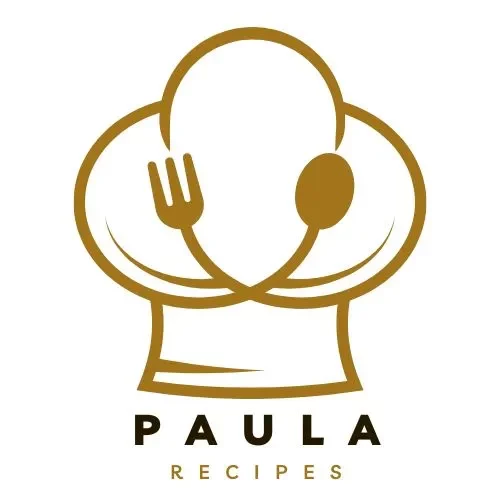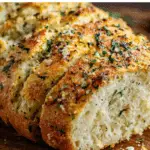There’s something magical about the aroma of freshly baked bread wafting through the house. Growing up, the weekend wasn’t complete without the scent of butter and herbs mingling in the kitchen as my grandmother pulled out a golden loaf of her famous Garlic Parmesan Herb Bread. She’d always say, “A good bread brings people to the table, but great bread keeps them there.” This flavorful loaf, crusty on the outside and soft on the inside, was always the star of our Sunday dinners, paired perfectly with pasta or soup.
In this article, we’ll dive deep into everything you need to know to master this homemade favorite. We’ll cover its origins and flavor profile, walk through the ingredients that make it unforgettable, and explore techniques that ensure it turns out perfect every time. Along the way, you’ll also discover how to pair it for different occasions, and you’ll be treated to some helpful links like garlic swirl rolls and cheesy parmesan mozzarella bites for even more bread-based inspiration.
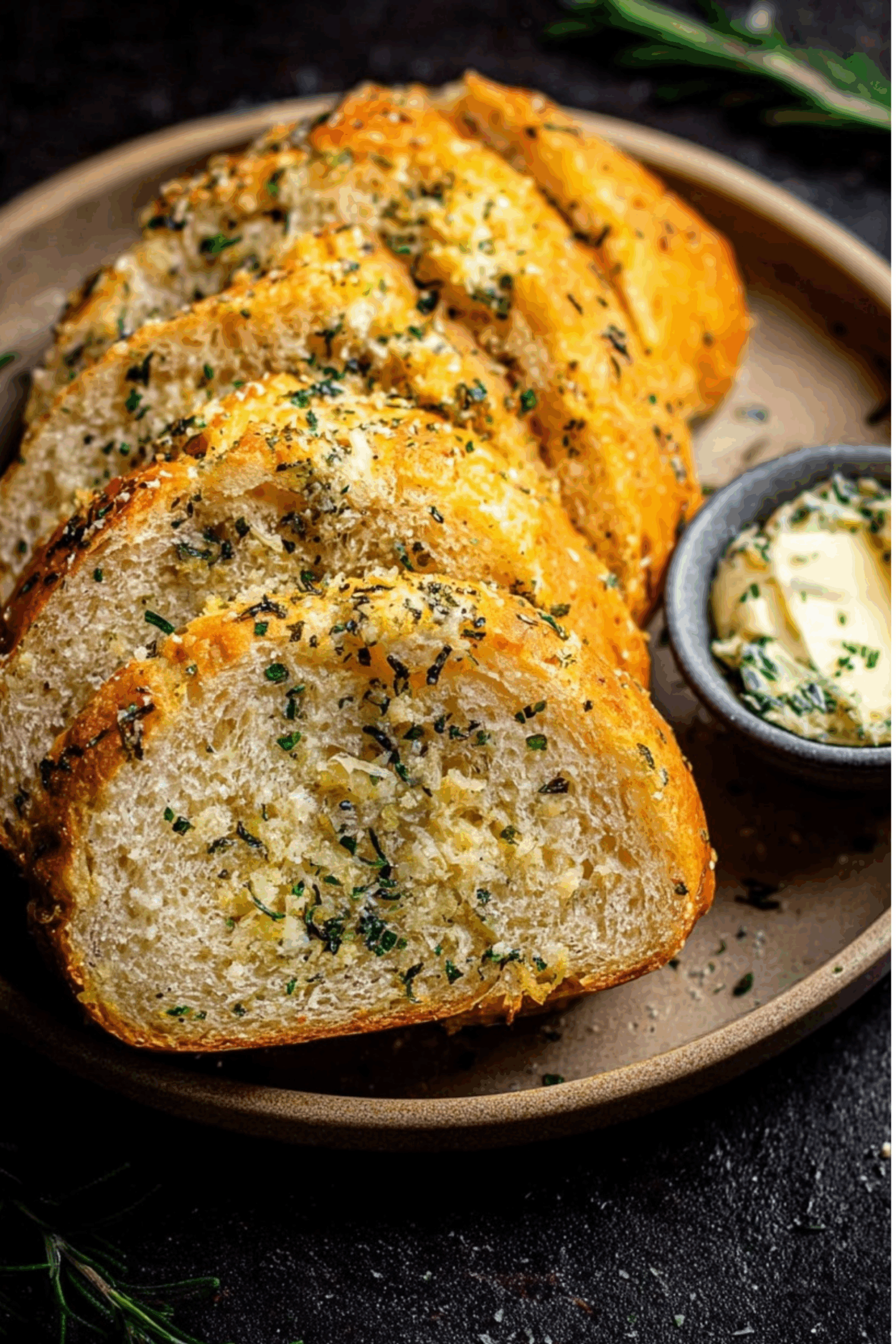
The Story Behind Garlic Parmesan Herb Bread
Why Garlic Parmesan Herb Bread Captivates Every Table
Garlic Parmesan Herb Bread isn’t just delicious—it’s nostalgic. The garlic infuses the entire loaf, delivering a warm, comforting aroma, while the parmesan adds depth with its savory sharpness. Combined with herbs like rosemary, thyme, or basil, it becomes a loaf bursting with rustic character.
It’s also one of the most versatile bread recipes you’ll find. Whether you’re hosting a cozy dinner, preparing appetizers for a party, or just want something hearty to accompany your soup, this bread works beautifully. Plus, it pairs well with recipes like olive garden breadsticks or complements dishes like cheesy breadsticks with ease.
Print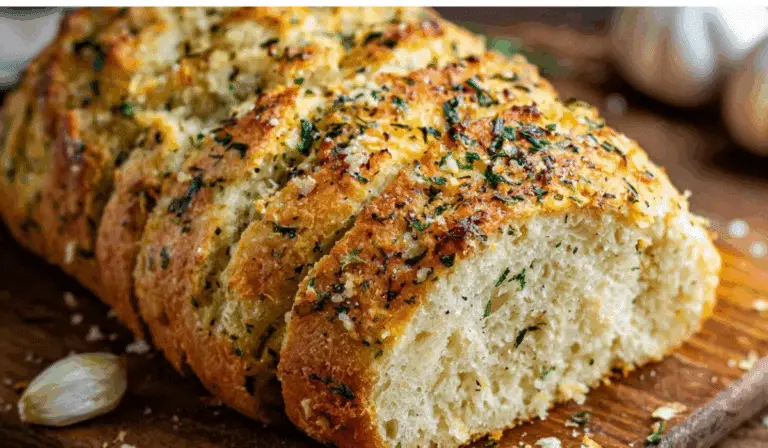
Garlic Parmesan Herb Bread: A Savory Staple for Every Season
Fluffy and crusty Garlic Parmesan Herb Bread loaded with rich flavor from roasted garlic, herbs, and freshly grated parmesan.
- Total Time: 2 hours
- Yield: 1 loaf 1x
Ingredients
- 3 cups all-purpose flour
- 1 tbsp sugar
- 2 tsp instant yeast
- 1 tsp salt
- 1 tbsp olive oil
- 1 cup warm water
- 1/2 cup grated parmesan
- 4 cloves garlic, minced or roasted
- 1 tbsp chopped fresh herbs (rosemary, thyme, parsley)
Instructions
- In a large bowl, mix flour, sugar, yeast, and salt.
- Add warm water and olive oil; mix until dough forms.
- Fold in garlic, parmesan, and herbs.
- Knead on floured surface 8 minutes until elastic.
- Cover and let rise 1 hour until doubled.
- Shape into loaf and place in greased pan.
- Let rise again 30 minutes.
- Bake at 375°F for 30 minutes until golden brown.
- Cool before slicing. Serve warm or room temp.
Notes
- Use fresh parmesan for best flavor
- Roast garlic for a milder taste
- Can be frozen up to 3 months
- Prep Time: 1 hour 30 minutes
- Cook Time: 30 minutes
- Category: Bread
- Method: Baking
- Cuisine: American
- Diet: Vegetarian
Nutrition
- Serving Size: 1 slice
- Calories: 170
- Sugar: 1g
- Sodium: 210mg
- Fat: 6g
- Saturated Fat: 2g
- Unsaturated Fat: 4g
- Trans Fat: 0g
- Carbohydrates: 22g
- Fiber: 1g
- Protein: 5g
- Cholesterol: 5mg
A Humble Origin with Endless Possibilities
The roots of this bread lie in classic Italian cuisine, where garlic and parmesan are pantry staples. Over time, home bakers started blending these with fresh or dried herbs, giving rise to countless variations. Some prefer it braided, others bake it in a skillet, and a few adventurous cooks stuff it with mozzarella or cheddar. Whichever direction you take, the foundation remains the same: bold flavor, fluffy texture, and a golden crust.
Today, this loaf represents more than just a side dish—it’s a centerpiece. And what makes it even better? It’s surprisingly easy to make at home, even if you’re not a seasoned baker.
Choosing the Best Ingredients for Flavor
Fresh Herbs vs. Dried: What Makes the Difference
When you’re baking Garlic Parmesan Herb Bread, herbs can make or break your flavor game. Fresh herbs like chopped rosemary or basil provide vibrant aroma and texture. Dried herbs, on the other hand, offer convenience and more concentrated flavor. The best strategy? Use a blend—dry oregano in the dough and fresh parsley for garnish works wonderfully.
This tactic also gives the bread that layered, herbaceous note you’ll find in dishes like golden crust garlic rosemary focaccia muffins—a crowd favorite!
The Right Parmesan and Garlic: Fresh is Best
Grated parmesan straight from the wedge—not the pre-shredded kind—is essential. It melts better, tastes sharper, and adds that slight salty nuttiness we crave. As for garlic, don’t skimp. Roast it if you want a mellow, buttery flavor or use minced raw garlic for a punchier bite. Both versions work depending on your taste and what you’re serving it with.
Pair it alongside savory mains like garlic butter chicken bites with creamy pasta to bring a dinner full circle.
Mastering the Art of the Dough
How to Avoid Dense Bread
Many home bakers struggle with dense or gummy bread, especially with cheese-heavy dough. The secret? Kneading and resting. Don’t over-knead or under-proof. Allow your dough to rise in a warm place until doubled in size, typically one to two hours. This ensures the gluten has developed properly, giving you that pillowy interior we all crave.
Another common issue is moisture imbalance. The addition of garlic and cheese can introduce more liquid into the dough, so make sure your flour ratio adjusts accordingly. You want a slightly tacky, not sticky, dough. This balance makes your bread similar in fluffiness to cheesy pull-apart Christmas tree bread, perfect for tearing and dipping.
The Importance of Temperature and Timing
Using lukewarm water to activate your yeast (around 110°F) is crucial. Too hot, and you kill the yeast. Too cold, and your dough won’t rise. Letting your dough rise at room temperature helps maintain flavor without over-proofing.
Bake at 375°F until golden brown—typically 25–30 minutes. For an extra crispy crust, spritz water into the oven right after putting the bread in. That burst of steam gives it that artisan bakery touch, much like what makes spaghetti garlic bread bowls so irresistible.
Creative Add-Ins and Variations
Going Beyond the Basics: Add Cheese and Spice
Once you’ve mastered the classic Garlic Parmesan Herb Bread, it’s time to experiment. Try folding in shredded mozzarella for a cheesy pull-apart effect or a handful of chopped sun-dried tomatoes for a Mediterranean twist. A touch of red pepper flakes can add a little heat without overpowering the garlic-parmesan flavor.
Many of these additions draw inspiration from savory sides like roasted garlic and parmesan carrots or festive breads like christmas tree spinach dip breadsticks, making your loaf holiday-ready.
Stuff It or Roll It for More Fun
For an appetizer-style bread, consider stuffing the dough with cream cheese and herbs before rolling it into balls or braiding it. Another approach is to roll out the dough flat, spread garlic butter and cheese, then roll and slice into pinwheels.
This technique not only adds flavor but makes the bread highly shareable. It’s a style that aligns beautifully with party favorites and casual holiday spreads.
Serving Ideas and Storage Tips
Best Ways to Serve Garlic Parmesan Herb Bread
Serve this bread warm, with a pat of butter or a small bowl of herbed olive oil. It’s a natural fit next to pasta dishes, creamy soups, and roasted meats. You can even make sandwiches with it, pairing beautifully with chicken or roast beef.
We especially love serving it alongside crispy baked eggplant or for contrast with something like honey mustard chex mix as a crunchy starter.
How to Store and Reheat for Maximum Freshness
Wrap leftovers tightly in foil or a bread bag and store at room temperature for up to 3 days. To reheat, sprinkle with a few drops of water and bake in foil at 350°F for 10 minutes. This revives the crust while keeping the inside moist. You can also freeze sliced bread and reheat individual pieces in the toaster or oven as needed.
For longer storage, slice and freeze in airtight bags. When the craving hits, pop it into the oven straight from frozen—no thawing needed. It’s as easy as pulling out deviled egg Christmas trees for a last-minute gathering or sharing a sweet treat like chewy Christmas toffee.
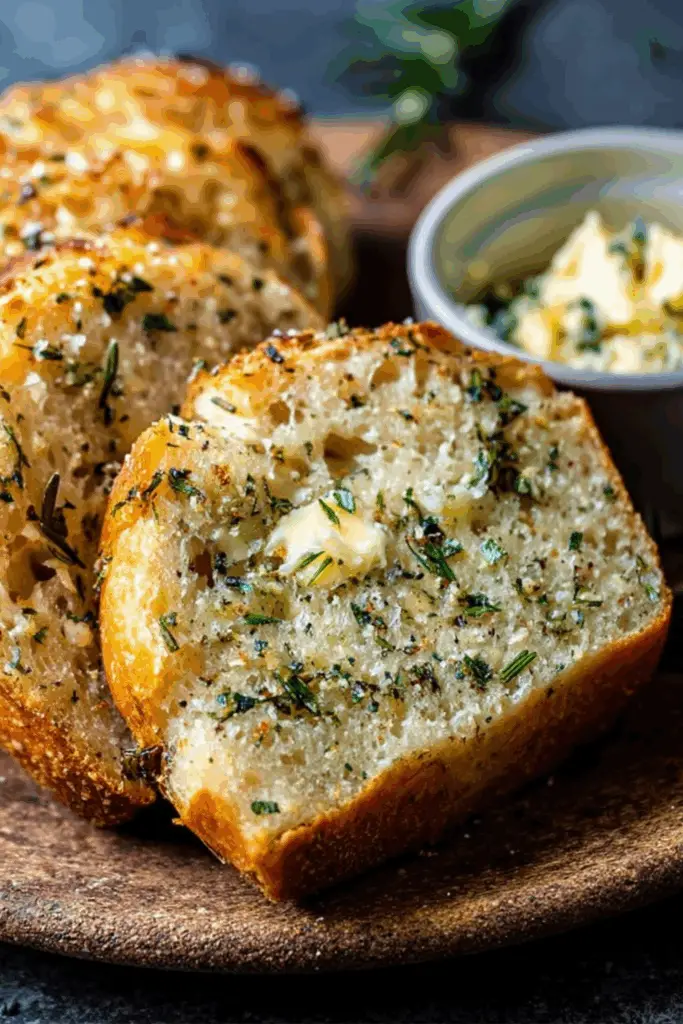
Serving Up the Final Words for Garlic Parmesan Herb Bread
Garlic Parmesan Herb Bread isn’t just another recipe—it’s a kitchen ritual. From the very first whiff of garlic sautéing in butter to the golden final crust, this bread invites warmth and comfort into your home. It’s a recipe worth repeating, whether you’re planning a laid-back family dinner or a holiday feast. With the right ingredients, a little patience, and some flavorful add-ins, you’ll create more than just a loaf—you’ll build memories around your table.
Don’t hesitate to make it your own. Add new herbs, change up the cheese, or shape it differently. That’s the beauty of bread like this—it’s as flexible as it is delicious. And if you’re looking to expand your savory baking game even more, check out recipes like shortbread cookies or even experiment with chewy Christmas toffee for sweet contrast.
FAQs: Garlic Parmesan Herb Bread
Can I use all-purpose flour instead of bread flour for Garlic Parmesan Herb Bread?
Yes, you can substitute all-purpose flour. Bread flour gives a chewier texture due to higher protein, but all-purpose works well if that’s what you have.
How can I make Garlic Parmesan Herb Bread gluten-free?
Use a 1:1 gluten-free flour blend designed for baking, and be sure your yeast and other ingredients are certified gluten-free. Results may vary in texture, so experiment to suit your preferences.
Can I freeze Garlic Parmesan Herb Bread?
Absolutely. Slice it before freezing so you can reheat individual portions. Wrap tightly in foil or place in a freezer-safe bag for best results.
What herbs pair best in Garlic Parmesan Herb Bread?
Rosemary, thyme, basil, and parsley are classic choices. Try a blend of dried oregano and fresh parsley for a balanced flavor. You can also explore with dill or chives for something different.
